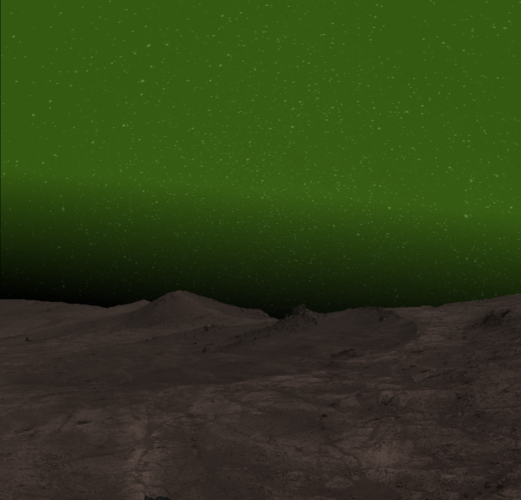
Copernical Team
A green glow in the martian night

When future astronauts explore Mars’s polar regions, they will see a green glow lighting up the night sky. For the first time, a visible nightglow has been detected in the martian atmosphere by ESA’s ExoMars Trace Gas Orbiter (TGO) mission.
Construction on NASA mission to map 450 million galaxies is under way
 NASA's SPHEREx space telescope is beginning to look much like it will when it arrives in Earth orbit and starts mapping the entire sky. Short for Specto-Photometer for the History of the Universe, Epoch of Reionization, and Ices Explorer, SPHEREx resembles a bullhorn, albeit one that will stand almost 8.5 feet tall (2.6 meters) and stretch nearly 10.5 feet (3.2 meters) wide. Giving the observato
NASA's SPHEREx space telescope is beginning to look much like it will when it arrives in Earth orbit and starts mapping the entire sky. Short for Specto-Photometer for the History of the Universe, Epoch of Reionization, and Ices Explorer, SPHEREx resembles a bullhorn, albeit one that will stand almost 8.5 feet tall (2.6 meters) and stretch nearly 10.5 feet (3.2 meters) wide. Giving the observato NASA's Solar Jet Hunter Project Revived with Fresh Data and New Interactive Tasks
 NASA's Solar Jet Hunter, a project that utilizes the collective power of citizen scientists to uncover the mysteries of solar jets, has made a triumphant return. After a brief hiatus, the initiative is now equipped with an influx of fresh data harvested from NASA's Solar Dynamic Observatory (SDO) and bolstered by new user-friendly features designed to enhance public involvement.
Solar jets
NASA's Solar Jet Hunter, a project that utilizes the collective power of citizen scientists to uncover the mysteries of solar jets, has made a triumphant return. After a brief hiatus, the initiative is now equipped with an influx of fresh data harvested from NASA's Solar Dynamic Observatory (SDO) and bolstered by new user-friendly features designed to enhance public involvement.
Solar jets China kicks off construction of new telescopes for future lunar missions
 China has recently launched the construction of two 40-meter-aperture radio telescopes in Shigatse, located in southwest China's Tibet Autonomous Region, and in Changbai Mountain area in northeast China's Jilin Province, respectively.
The two telescopes, developed by Shanghai Astronomical Observatory (SHAO) under the Chinese Academy of Sciences, are expected to offer technical support for
China has recently launched the construction of two 40-meter-aperture radio telescopes in Shigatse, located in southwest China's Tibet Autonomous Region, and in Changbai Mountain area in northeast China's Jilin Province, respectively.
The two telescopes, developed by Shanghai Astronomical Observatory (SHAO) under the Chinese Academy of Sciences, are expected to offer technical support for Milky Way-like galaxy found in the early universe
 Using the James Webb Space Telescope, an international team, including astronomer Alexander de la Vega of the University of California, Riverside, has discovered the most distant barred spiral galaxy similar to the Milky Way that has been observed to date.
Until now it was believed that barred spiral galaxies like the Milky Way could not be observed before the universe, estimated to be 13.
Using the James Webb Space Telescope, an international team, including astronomer Alexander de la Vega of the University of California, Riverside, has discovered the most distant barred spiral galaxy similar to the Milky Way that has been observed to date.
Until now it was believed that barred spiral galaxies like the Milky Way could not be observed before the universe, estimated to be 13. Webb, Hubble telescopes combine to create most colorful view of universe
 Astronomers once again have combined the observational powers of NASA's James Webb Space Telescope and Hubble Space Telescope to create one of the most detailed and colorful portraits of the cosmos, just in time for the holiday season.
The new image, dubbed the Christmas Tree Galaxy Cluster by the research team that includes Texas A and M University astronomer Dr. Lifan Wang, combines visi
Astronomers once again have combined the observational powers of NASA's James Webb Space Telescope and Hubble Space Telescope to create one of the most detailed and colorful portraits of the cosmos, just in time for the holiday season.
The new image, dubbed the Christmas Tree Galaxy Cluster by the research team that includes Texas A and M University astronomer Dr. Lifan Wang, combines visi Scientists find 14 new transient objects in space by peering through the 'Christmas Tree Galaxy Cluster'
 An international team of scientists, led by University of Missouri's Haojing Yan, used NASA's James Webb Space Telescope (JWST) to discover 14 new transient objects during their time-lapse study of galaxy cluster MACS0416 - located about 4.3 billion light years from Earth - which they've dubbed as the "Christmas Tree Galaxy Cluster."
"Transients are objects in space, like individual stars,
An international team of scientists, led by University of Missouri's Haojing Yan, used NASA's James Webb Space Telescope (JWST) to discover 14 new transient objects during their time-lapse study of galaxy cluster MACS0416 - located about 4.3 billion light years from Earth - which they've dubbed as the "Christmas Tree Galaxy Cluster."
"Transients are objects in space, like individual stars, Extended habitability of exoplanets due to subglacial water
 Professor Amri Wandel, from Hebrew University of Jerusalem, has unveiled research that promises to redefine our comprehension of habitable exoplanets. In a recent study published in the Astronomical Journal, Professor Wandel introduces the concept of subglacial liquid water as a pivotal element in broadening the boundaries of the conventional Habitable Zone.
The classical Habitable Zone, o
Professor Amri Wandel, from Hebrew University of Jerusalem, has unveiled research that promises to redefine our comprehension of habitable exoplanets. In a recent study published in the Astronomical Journal, Professor Wandel introduces the concept of subglacial liquid water as a pivotal element in broadening the boundaries of the conventional Habitable Zone.
The classical Habitable Zone, o Juno finds Jupiter's winds penetrate in cylindrical layers
 Gravity data collected by NASA's Juno mission indicates Jupiter's atmospheric winds penetrate the planet in a cylindrical manner, parallel to its spin axis. A paper on the findings was recently published in the journal Nature Astronomy.
The violent nature of Jupiter's roiling atmosphere has long been a source of fascination for astronomers and planetary scientists, and Juno has had a rings
Gravity data collected by NASA's Juno mission indicates Jupiter's atmospheric winds penetrate the planet in a cylindrical manner, parallel to its spin axis. A paper on the findings was recently published in the journal Nature Astronomy.
The violent nature of Jupiter's roiling atmosphere has long been a source of fascination for astronomers and planetary scientists, and Juno has had a rings Bulgaria signs Artemis Accords at NASA Headquarters; Joins 31 Nations
 NASA Administrator Bill Nelson participated in a signing ceremony Thursday with Bulgaria's Milena Stoycheva, minister of innovation and growth, as her country became the 32nd nation to sign the Artemis Accords.
The Artemis Accords establish a practical set of principles to guide space exploration cooperation among nations, including those participating in NASA's Artemis program.
Also
NASA Administrator Bill Nelson participated in a signing ceremony Thursday with Bulgaria's Milena Stoycheva, minister of innovation and growth, as her country became the 32nd nation to sign the Artemis Accords.
The Artemis Accords establish a practical set of principles to guide space exploration cooperation among nations, including those participating in NASA's Artemis program.
Also 































